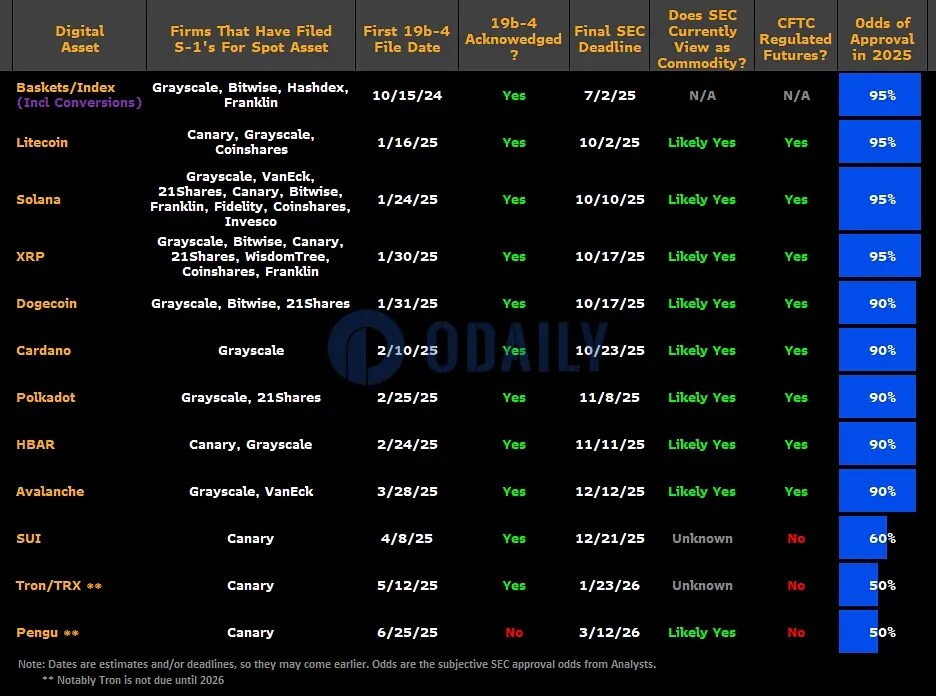Original | Odaily Planet Daily ( @OdailyChina )
Author | Dingdang ( @XiaMiPP )

Yesterday, Bloomberg reported that Trump will sign an executive order Thursday aimed at allowing private equity, real estate, cryptocurrencies, and other alternative assets to be included in 401(k) retirement plans. This news lifted the gloom brought on by the tariffs, leading to a strong performance in the crypto market. Bitcoin surged past the $115,500 resistance level, while Ethereum once again pushed towards the $4,000 mark, sending the altcoin sector into a frenzy. Is the long-awaited "altcoin season" finally here?
What is a 401(k)? Why is the new policy so significant?
401(k) plans are one of the most important retirement savings tools in the United States, managing approximately $9 trillion in assets and covering the retirement funds of tens of millions of Americans. As employer-sponsored long-term savings plans, 401(k) plans traditionally focus on low-risk, highly liquid assets such as stocks, bonds, and mutual funds, aiming to provide retirees with stable, long-term returns.
Trump's executive order directly rips apart this conservative framework— for the first time, explicitly allowing high-risk, high-return alternative assets into the 401(k) system, including cryptocurrencies, gold, private equity, and real estate. This means trillions of dollars in retirement funds could flow into previously considered "non-mainstream" markets, reshaping the investment landscape of US pension funds. For related reading, see " Big News: Trump Plans to Open US Pension Funds to Crypto Investment, Will Trillions of Dollars Flood the Market? "
This isn't the first time Trump has attempted to loosen 401(k) investment restrictions. Back in 2020, his Department of Labor signaled the possibility of allowing 401(k)s to access private assets. However, the lack of a presidential executive order, coupled with the low liquidity and limited transparency of private assets, ultimately failed to garner widespread adoption. This time, the new policy, signed personally by the president, is both more forceful and demonstrates a clearer commitment to its implementation.
In May 2025, the U.S. Department of Labor took the lead in revoking the Biden-era restrictive guidance on the inclusion of cryptocurrencies in 401(k)s, paving the way for this step. At the same time, the Federal Housing Finance Agency also required Fannie Mae and Freddie Mac to include borrowers' crypto assets in their mortgage loan assessments, demonstrating that the Trump administration is attempting to integrate crypto assets into the mainstream of the U.S. economy at multiple levels.
Market estimates suggest that if 401(k) plans allocated just 2% of their assets to cryptocurrencies, it would represent approximately $170 billion in new capital inflows—equivalent to two-thirds of the market capitalization of existing crypto spot ETFs and listed reserves. Such a massive influx of funds would be enough to stir the entire crypto market.
However, the policy's implementation won't be immediate. The executive order requires the Department of Labor and the Securities and Exchange Commission (SEC) to develop detailed regulatory rules and establish a "safe harbor" mechanism for 401(k) plan administrators to mitigate potential legal risks from offering high-risk assets. The development of the regulatory framework could take months or even years, and the investment ratios and specific asset ranges still need to be clarified. Even so, its symbolic significance and potential impact are enough to capture market imagination.
State-level pilots are underway, while institutions are rushing to establish their presence
Before federal policies were fully implemented, some state governments had already taken the lead in testing the waters.
In March 2025, North Carolina introduced the North Carolina Digital Asset Investment Act (House Bill 92), authorizing the state treasurer to invest up to 5% of the state's public retirement fund in digital assets such as Bitcoin. Republican Representative Mike Schietzelt, the bill's sponsor, said it "opens up a new asset class" for the state's fiscal health. As of May 2025, the bill had passed the House of Representatives and was still under consideration in the Senate.
Wisconsin and Michigan are already at the forefront. In May 2024, the Wisconsin Investment Commission disclosed that it had purchased approximately $160 million worth of Bitcoin spot ETFs (primarily invested in BlackRock ETFs), representing 0.1% of its over $100 billion pension fund. Although this amount was reduced to $104 million in September, it set a precedent for US state-level pension funds to allocate crypto assets. Michigan disclosed in July 2024 that its pension fund had purchased approximately $6.5 million worth of Bitcoin ETFs for inclusion in the retirement portfolios of state employees and teachers.
Arizona is also active. In February 2025, Republican state senator Jake Hoffman proposed that the state retirement system consider allocating Bitcoin ETFs.
Although the scale of these investments is not large, they are seen as a signal of "testing the waters" for state-level pensions and provide a reference sample for other states.
Meanwhile, Wall Street institutions are keenly monitoring policy trends and accelerating their efforts to seize opportunities in the 401(k) market. Fidelity Investments, an industry giant with $5.9 trillion in assets under management, launched a cryptocurrency-supported retirement account product in April 2024, allowing investors to invest in Bitcoin and Ethereum spot ETFs through their self-directed brokerage (SDB) accounts.
Blackstone President Jon Gray stated that leading institutions in the alternative asset sector will be the first to benefit from the new 401(k) policy, which is expected to attract hundreds of billions of dollars in capital inflows. Blackstone is collaborating with Morgan Stanley to develop private equity investment tools for 401(k) plans, lowering the barrier to entry and attracting small and medium-sized investors. Apollo Global Management has partnered with State Street to launch a target date fund (TDF) that includes private equity, designed specifically for retirement savings, balancing returns and risk management. BlackRock is also actively developing 401(k) products that support crypto spot ETFs and real estate investment trusts (REITs). Robert Mitchnick, BlackRock's head of digital assets, stated that they are conducting in-depth research and education with pension fund managers to help them understand crypto asset investments.
These state and institutional actions demonstrate that both local policy experiments and Wall Street's strategic planning are paving the way for 401(k)s to open up to alternative assets. Cryptocurrency, as a high-risk, high-return asset class, is gradually being integrated into the U.S. retirement savings system.
Where is the money flowing? The crypto space is welcoming new opportunities.
The $9 trillion 401(k) asset base has given the crypto market unprecedented growth potential. Even a small influx of funds could significantly drive up the prices of mainstream crypto assets like Bitcoin and Ethereum. Crypto spot ETFs, in particular, offer advantages in regulatory compliance, custodial security, and liquidity, and are likely to be among the first to benefit.
Odaily Planet Daily previously discussed in its article " Where is Institutional Money Flowing? Unveiling the Five Golden Tracks for This Potential "Altcoin Season" " that in this new institutional-led funding cycle, assets with high liquidity and transparency are more likely to be favored. In addition to Bitcoin and Ethereum spot ETFs, projects like SOL, XRP, LTC, and DOGE also have a high probability of receiving ETF approval , thereby benefiting from this wave of pension fund inflows.

Market disputes and risk warnings
Despite the market enthusiasm, academics and regulators have expressed strong concerns about the high-risk characteristics of alternative assets.
Johns Hopkins University professor Jeffrey Hooke bluntly stated that including private equity and cryptocurrencies in 401(k)s is a "bad idea." He pointed out that private equity has poor liquidity and high fees, and its long-term returns may not be better than those of traditional stocks. Meanwhile, cryptocurrencies, due to their extreme volatility (for example, Bitcoin plummeted over 60% in 2022) and short history, are not a reliable option for retirement savings.
Jerry Schlichter, a partner at Schlichter Bogard, a law firm specializing in high-fee 401(k) litigation, warned: "The average person's retirement goal is security and stability. Cryptocurrencies are fraught with unknown risks and experience significant short- to medium-term volatility, making them unsuitable as a core retirement asset."
Democrats are also cautious about the policy. Senator Elizabeth Warren and others have criticized the Genius Act's regulatory framework as overly lax, expressing concern that allowing large corporations to issue private cryptocurrencies could destabilize the financial system. They describe ordinary depositors as potentially becoming "guinea pigs in policy experiments" and call for stricter oversight and risk assessment.
Conclusion
Trump's executive order is opening an unprecedented policy opportunity for the crypto and alternative asset industries. If trillions of dollars in 401(k) funds flow into the system in batches, this will not only shift capital flows but also enhance the legitimacy and influence of crypto assets within the mainstream financial system.
But opportunities come with risks. The development of regulatory details, market education, and the setting of investment ratios will all determine the effectiveness of this transformation. In the coming months, investors will need to closely monitor the subsequent actions of the Department of Labor and the SEC, as well as the actual pace of institutional investment.
For the crypto market, this may not only be a feast of funds, but also a key turning point for crypto assets to truly enter the mainstream financial stage.
- 核心观点:特朗普新政允许养老金投资加密,或引发万亿美元流入。
- 关键要素:
- 401(k)计划管理9万亿美元资产。
- 新政首次明确允许加密等另类资产进入。
- 2%配置或带来1700亿美元新增资金。
- 市场影响:加密市场或迎大规模资金流入。
- 时效性标注:中期影响。



